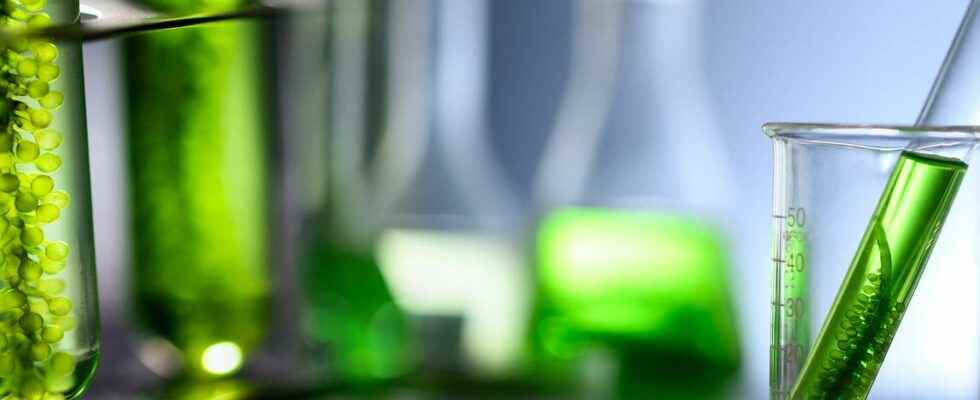Microalgae, by definition, are invisible toeye naked. They measure barely a few tens of micrometers. Less than the diameter of a hair. And some are talked about because they produce toxins.
But microalgae don’t just produce toxins. Far from it, even. Of some 40,000 species currently identified in the world, less than a hundred seem to manufacture toxic substances. For men or for biodiversity Marine. “Others microalgaethey produce molecules which may be of interest – the proteinof the lipids, pigments, etc. », explains Guillaume Charpy, CEO of the start-up CarbonWorks. All the more interesting as these microalgae are photosynthetic. Understand that they manufacture these molecules from carbon dioxide (CO2). A little as if nature offered us so many machines to to recycle CO2 that we issue in theatmosphere.
Capture CO2 and enhance it with microalgae
Of course, you know, this CO2, it is a problem. Because he is primarily responsible for global warming that we are currently experiencing. So all the means to eliminate it, to neutralize it, seem good to take. Including, given the urgency in which we find ourselves today. In this case, the capture and recovery of CO2. What experts call the CCU – for Carbon Capture and Utilization.
An alternative resource to fossil carbon
“In real life, it’s a bit complicated. But the concept itself is simplecontinues Guillaume Charpy. Industry needs carbon. And rather than recovering ever more carbon fossil– by extracting oilnotably –, we offer him another resource. »
To grow, CarbonWorks microalgae need CO2. “This CO2we will pick it up directly from an industrial company”, explains Guillaume Charpy. How ? By simply connecting a photobioreactor – an enclosed basin in which the algae in question – to emissions industrial… through a pipe. “That’s the easiest part, after all. »
However, it should not be forgotten that two major ingredients are involved in the photosynthesis. CO2, we have just seen. But also a dose ofenergy. energy in the form of light. The light of Sun when talking about extensive CCU. Here, the objective is to go up a notch. To do intensive CCU. “So that yields are better than in nature – CarbonWorks is still aiming for 5,000 tonnes of biomass per hectare per year –we need to bring light to our microalgae”, explains the CEO of CarbonWorks. Hence the term ” Photo “ in the word photobioreactor.
Here, everything is ready. The microalgae only have to absorb the carbon (C) contained in the CO2 and reject oxygen (O2) to the atmosphere. Everything is ready ? Not quite yet. Because it is also necessary, a little, to feed the algae. Withnitrogenfrom phosphorus and potassium. “Nothing but very classic for plants. »
And then, harvest time arrives. In practice, it is done continuously, “a few days after the first inoculation”. The molecule of interest can finally be extracted. “At the rate of a few hundred to a few thousand tons. » To serve, if possible, the industrialist who supplied the CO2 necessary to manufacture it. “But any other industrialist can also benefit from it. »
Double decarbonizing the industry
CarbonWorks’ ambition is finally to double decarbonize industry. By capturing CO2 that it emits, first. Then by providing manufacturers with matter biosourced first to replace the fossil raw material they are used to exploiting. All without harming biodiversity, with low water consumption and a small footprint. An influence, moreover, on industrial land. Not on farmland. “Our goal is to capture 10,000 tonnes of CO2 per hectare per year. Knowing that a forest sequesters between 13 and 37 tons of CO2 per hectare per year. And that a field of cornwhich is considered a good CO trap2does not exceed 20 tonnes per hectare per year”figure for us Guillaume Charpy.
Currently, CarbonWorks has a demonstrator. He is based in Cestas, in Gironde. And it produces a fungicide. Partnerships have been concluded – or are under discussion – for the supply of raw materials to the sectors ofagriculture – human food, but also animal food -, cosmetics, pharmaceuticals and chemistry. “Until the end of 2023, we will still be going back and forth between testing new technological bricks on a small scale and testing on a larger scale. By 2025, we hope to be able to start up our first elementary module of intensive CCU from microalgae. »
“For now, we are not yet on an industrial scale”, recognizes Guillaume Charpy. But the CEO believes in its business model. “We don’t aim to become specialists in fungicides or pigments. We are specialists in this breakthrough technology for intensive CCU. Microalgae specialists. These are the skills, and only these, that we are going to put at the service of the industry. » And as the demand in bio-based raw material is increasing and the CO resource2 is, to say the least, bloated…
Reading ideas for the summer with Futura?
To celebrate the start of the holidays, we offer you the Mag Futura at the preferential price of 15 € instead of 19 €, i.e. a reduction of 20% !
What is Mag Futura?
- Our first paper journal of more than 200 pages to make science accessible to as many people as possible
- 4 major scientific questions for 2022, from the Earth to the Moon
- Home delivery*
*Special offer valid until July 19. Delivery is made in France (excluding metropolitan France), Switzerland, Belgium.
Interested in what you just read?
